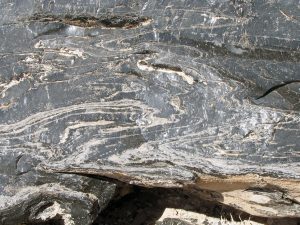At the southern end of the Salton Sea lake are five volcanic flows called the Salton Buttes. This area is in Southern California’s Salton Trough. The Salton Trough is a pull-apart basin between strike-slip faults along the Pacific-North American plate boundary. Here, the five Buttes have an estimated total volume of more than 5 cubic kilometers (about 1 cubic mile). The volcanic flows are associated with magma at depth under the Salton Sea geothermal field. The Buttes represent high silica volcanic flows of rhyolite composition and often are glassy obsidian.
These rocks are so glassy and fine grained that it is difficult to obtain appropriate crystals for radioisotope crystal age dating. Radioisotope dating of geologically young rocks is inherently difficult because radioactive decay daughters have had little time to accumulate. In addition, the eruption of the Buttes was not associated with trapped plant or other carbon-bearing items, so Carbon-14 age dating is not possible. The Buttes were previously estimated to be between 16,000 and 2,400 years old using the techniques available at the time, but those techniques were not precise.
The United States Geological Survey California Volcano Observatory (USGS-CalVO) investigates and monitors volcanic hazards in California. Any volcanic eruption less than 10,000 years old is considered an “active volcanic area” since it might erupt again and pose a threat to the public. Recent advances in single crystal radioisotope age dating techniques have made it possible to more accurately determine the date of the Buttes. With the increased focus on the declining Salton Sea lake, and the associated wetlands mitigation projects, and energy and farming development around the Buttes, the USGS-CalVO elected to revisit obtaining an accurate date on the eruption of the Buttes.
Alexander Schriener, Jr., Associate Geologist at Earth Systems, was working as Director of Geothermal Resources for CalEnergy Operating Corporation (CalEnergy) at the time of the study. He has been associated with the geothermal industry for over 36 years and with the Salton Sea geothermal field for over 20 years. Alex assisted the USGS-CalVO team obtain access to proprietary rock samples and other data regarding the Buttes, and provided his expertise regarding the geology of the geothermal reservoir and the Buttes.
To better constrain the Buttes’ history, the USGS-CalVO team used three independent dating techniques:
- Argon-Argon (40Ar/39Ar) anorthoclase crystal ages;
- Uranioum-Thorium (238U-230 Th) zircon crystallization ages; and,
- A comparison of signatures of the shifting direction of Earth’s magnetic field with the focus on Holocene.
The Holocene represents the last 11,700 years of Earth time. This study confirmed that the five dome-shaped Buttes were all formed during the Holocene. Despite the fact that the Buttes have similar compositions, their paleo-magnetic characteristics indicate that they erupted during three distinct episodes of volcanism within 500 years to 5,900 years between first and last eruption. However all but one of the flows have age dates that are nearly identical at about 2,800 years old or slightly younger. Thus, it appears that all these flows erupted within a few 100 years of one another. The age of the one other flow is poorly constrained since it has very few crystals and has the least available subsurface data.
So, the Salton Buttes erupted within a few 100 years of one another and they are less than 3,000 years old. These Buttes are considered the only “active” volcanic center in Southeastern California. This approach demonstrates the potential for combining advanced analytical techniques to yield meaningful age dates, even for very recent eruptions.
Note: Alexander Schriener, Associate Geologist at Earth Systems, was the co-author of this recent paper. The main work was accomplished through the United States Geological Survey, Menlo Park California, office. EOS (the Scientific journal) elected to post an abstract of this paper here.











